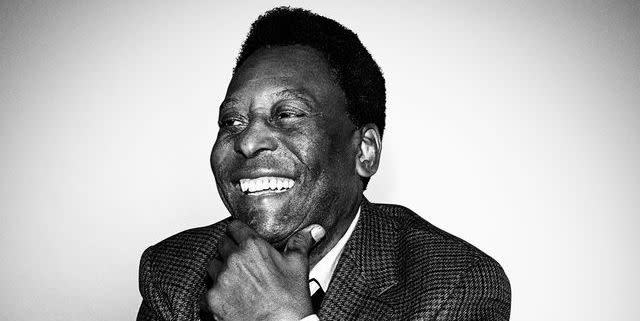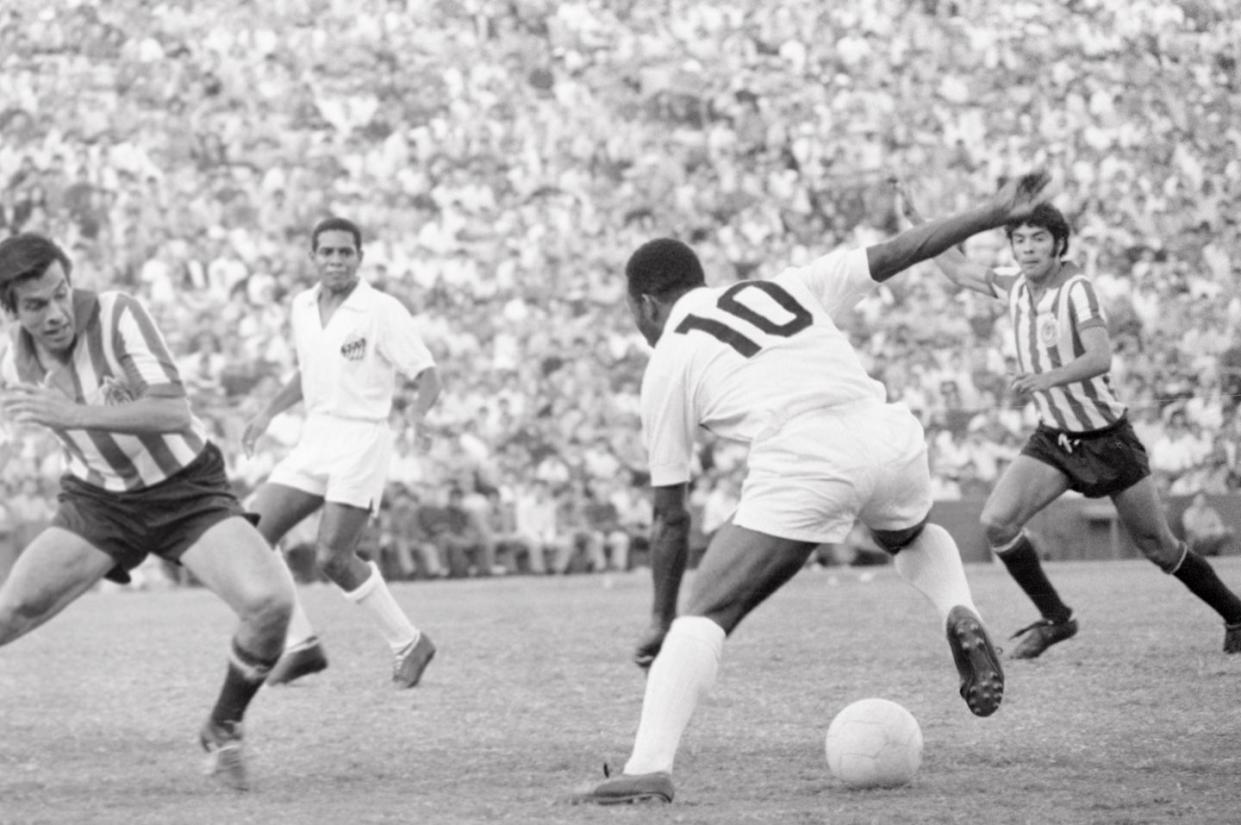I Met Pelé in a Drab Midtown Hotel Room. It Was Like Meeting the Pope at the Vatican.

The International Olympic Committee’s Athlete of the Century was sitting at a little table near the window in a hotel room in midtown Manhattan. The room was thoroughly beige, and the white-gray of an overcast day came through the window. There were movie posters here and there, boxes of them to add some cardboard to the color palette. A couple of men who I came to assume were producers on the film were milling or lurking about. It was not a setting to savor, in other words, much less any kind of pantheon, and yet there he was, the great man, the wizened elder of the world’s game, an almost papal presence in a gray herringbone blazer. His cliff of jet-black hair rose splendidly from his head, and when he caught sight of the room’s new additions, he welcomed us in with a smile wide and bright and wonderful, tugging you towards him like a tractor beam. All at once it was foretold that I would go and greet him, and so I went over to the table and shook the hand of Pelé. The skin of his face looked half his 76 years, and why not? The benefits of immortality.
These are only words, of course, and Pelé’s time has come like it will for all the rest of us, those who cannot claim to have changed everything in front of the whole world. Edson Arantes do Nascimento died Thursday at the age of 82 following a battle with cancer. It is fitting that this man should make his exit 11 days after the final of the World Cup, the quadrennially constructed stage where he and his compatriots regularly announce for all to see that soccer’s holy spirit resides in Brazil. When the talisman of the current generation, Neymar Jr., put one Brazilian foot in the semifinals earlier this month with a scything run buttressed by one-twos on his left and then his right, cutting open the Croatian defense with the deft touch of a samba surgeon, it drew comparisons to a goal in which Pelé played a part: that goal in 1970, the masterpiece to which Carlos Alberto applied the final brushstroke, one of those miracles of collective inspiration from which so much footballing art comes to seem derivative. There could be no Neymar without a Pelé, it hardly needs saying. Would there even be a Maradona?
It’s not the kind of thing you would hear from the man himself, mind you, at least in those later years. He possessed the kind of absolute self-assurance befitting his station, that transcendent calm of a man in whom the unassailable accomplishments of youth and the wisdom of age mingle in harmony. Neymar equalled his goalscoring record for Brazil with that sublime quarterfinal goal, but no one would say that Neymar has equalled Pelé. And what would it matter if they did? He is Pelé, the protagonist of the Book of Soccer Genesis. The number 10 is the number 10—the hallmark of the supreme creative force in any team, the maestro, the one who makes the difference—because he did what he did with those digits on his back.
No number 10 looks like his did, streaming down the center of the pitch at ferocious speed, beguiling defenders with quick chops and changes of direction, the body feints that seem to bring sleight-of-hand to the torso, the slick and savage nutmegs. He carries the ball over defenders with a juggling pop, around them and past them and through them. There’s an argument that many of the signature moves of latter-day great players—The Cruyff Turn, Neymar’s hesitating paradinha—first made an appearance in his repertoire. Even at his first World Cup in 1958, at the age of 17, you see a fabulously skilled technician who can also call upon a brawny power that belied his 5 feet and 8 inches. When he got in behind the opposing midfield and started running at the back line, it was something like seeing LeBron James on the fast break.
Lionel Messi was long dogged by his inability to add the World Cup to his sprawling trophy cabinet, but Pelé had no such problem. He won it three times, first as a teenager and last as part of one of the great teams of all time in 1970. He won the Brazilian league with his beloved Santos six times, along with the Copa Libertadores—the South American equivalent of the Champions League—twice. Reports vary, but by one account he scored 1,279 goals in 1,363 games. He had 77 in 92 for Brazil. It took Neymar 32 more matches to catch him.
But along with the stats and the silverware, there was the statesmanship. Pelé has been called “the first Black global sporting superstar,” and his embrace with England’s Bobby Moore at the 1966 World Cup remains a testament to sport’s capacity to unearth the humanity beneath the brutalist social structures we’ve constructed across the last two centuries. But he became a kind of ambassador for the game—more so, even, than for Brazil—before his playing days were done. When I asked about his decision to go play in the United States for the New York Cosmos in the twilight of his career, he said he’d settled on retiring as a Santos player. Years before, he’d been declared a national treasure of Brazil, a governmental attempt to keep him from seeking professional contracts abroad, and though he finally could leave, he didn’t intend to.
“But then Mr. Kissinger came to Sao Paulo,” he told me in the beige hotel room.
“Henry Kissinger?”
“Henry Kissinger. He invited me to go to the cafe with him, and there he said, ‘Listen. You know I'm from the United States, and I'm in politics there. Soccer is coming along there—they're playing it in the schools. Would you like to help us promote soccer in the United States?’ And I said, ‘My God.’”
It wasn’t the only time that those who may not have had the purest of hearts sought to recruit Pelé for their own ends, and in later years he drew sniping criticism—not least from the renegade genius Diego Maradona and his fans—for his service to FIFA and, generally, The Man. He told me his stint in America gave him the opportunity to learn English, though, and it proved a significant milestone on his road from “The King” to the Pope.

All the while, though, he kept a flame for the artistry of the game, the rhythms of it and the flourishes that he grew to master in the days when he played in the dirt without shoes. The movie I interviewed him about, Pelé: Birth of a Legend, was hardly an inspiration, but it did linger usefully on the concept of ginga—a traditionalist term for the Brazilian style of play, one rooted in the martial art of capoeira and defined by one's rhythm in moving with the ball to deceive an opponent. Ginga is a broader current in Brazilian life that defined the game as played by Pelé and his friends as schoolboys, the game of futsal practitioners and beach jugglers in Rio. But when he arrived at training camp for the national team in 1958, there was a wave of reaction against it in Brazil. The 1954 team had been kicked out at the quarter final stage by a Hungarian team that epitomized the physicality and tactical rigidity that defined European teams in that moment—and brought them success.
“There were some in Brazil who thought we should make that our football culture,” Pelé said. “We would say, ‘We want to dance. We want to ginga. Football is not about fighting to the death. You have to play beautifully.’ And so we did, and that's the reason that Brazil created more of a show, more of a ballet, than the European style.” And in 1958, of course, they won.
As the Brazilians found out in the tournament’s latest edition, such artistic justice is hardly guaranteed. You can tell a Brazil team is truly dangerous when they step off the bus for a match carrying instruments of all kinds, drumming samba rhythms as they sashay at their own pace to the locker room, layers of exquisite Nike gear arranged perfectly askew. Like capoeira, the grace has a lethal undercurrent, and Neymar and Co. had it all when they arrived in Doha in 2022. They dismantled teams, even when Neymar was forced out of the latter two group games having been kicked off the pitch by Serbia in matchday one. It was an opposition strategy that Pelé may have very personally recognized. In the quarterfinals, they ramped up the tempo over and over again, Coach Tité bringing on star after attacking star to give the Croatians groovy nightmares. When Neymar secured the lead in extra time in such style, it felt as if it might be 1958 all over again. And then it went to penalties, it all fell to pieces, and the artists and artisans went crashing out.
Pelé might have watched it from his hospital bed, and he may have felt a touch of despair. The Brazilians had once again engaged in the struggle to create and nurture beauty in a harsh and unforgiving world, to grow flowers they knew would be met with steel. Brazil had strength and power of their own in central midfield and defense, and the Croatians had their own artists, Luka Modric chief among them. But there is no substitute for the canary yellow jerseys flowing all around each other as one, shifting hips and sliding feints, the sublime power of the unpredictable. "His great secret was improvisation,” the aforementioned Carlos Alberto once said of Pelé. “Those things he did were in one moment." The King would always proclaim that the game truly belongs to those who seek to create something out of nothing, to fulfill the ultimate promise of sport: nothing is written, and anything can happen next.
Maybe, then, we’ll choose to believe that’s what he saw in the offer from Henry Kissinger, and in the offers to represent FIFA, and in the offer to make an ultimately lackluster movie about his life. I had a different sort of feeling in the beige hotel room, but I did not ask whether he needed the money. It would feel, to belabor it all, like shaking the Pope’s hand while pointing out a scuff on the floor at the Vatican. This was the man who across his playing career seemed to deliver the sport into vivid color, having first produced his magic in black and white. And there, in the gray light filtering in the window from the clouds above New York City, the whole planet seemed to revolve around a drab little hotel room. Now Pelé, in all his magic and magnetism, has left the building.
You Might Also Like
